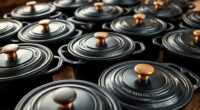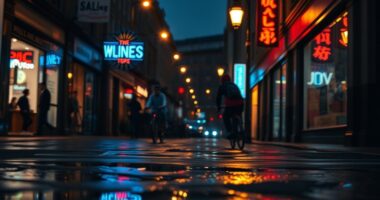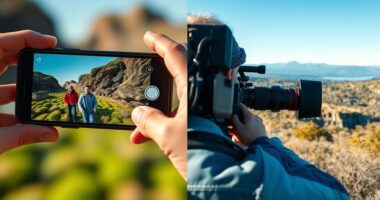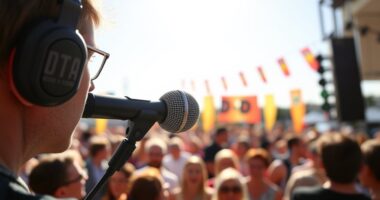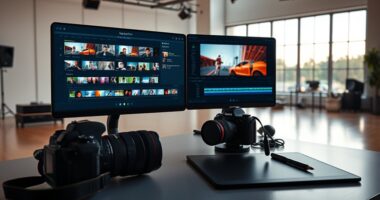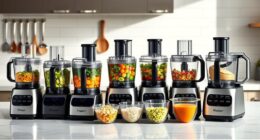When working with the LD for festival music videos, clearly communicate your vision for mood and atmosphere, emphasizing desired emotional tones through color temperature and lighting angles. Collaborate early and often to adjust lighting choices that match shifts in performance dynamics, using angles and colors to heighten excitement or emotion. Experimenting with angles and color temperature helps convey energy and mood effectively. Keep exploring these techniques to create visually compelling and emotionally resonant festival videos.
Key Takeaways
- Clearly communicate the desired mood and atmosphere to the lighting designer early in the planning process.
- Specify color temperature preferences (warm or cool tones) to match the emotional tone of each scene.
- Collaborate closely during setup to ensure lighting angles and intensities enhance scene dynamics and performer expressions.
- Adjust lighting angles and color tones throughout the shoot to reflect mood transitions and scene shifts.
- Maintain consistent communication with the LD to align lighting choices with the overall visual storytelling vision.

Have you ever wondered how festival music videos capture the vibrant energy and dynamic atmosphere of live performances? It all comes down to how you work with the lighting designer (LD) to create visually compelling scenes. One of the first things you’ll need to contemplate is the interplay of color temperature and lighting angles. These elements profoundly influence the mood, tone, and overall feel of your footage, helping you translate the raw excitement of a festival into a captivating visual story.
Color temperature is your tool for setting the emotional backdrop. Warm tones, like amber and orange, evoke feelings of intimacy, passion, and energy, making your audience feel like they’re right there in the crowd. Cooler tones, such as blue and purple, can add a sense of mystery or serenity, giving your video a layered depth. When collaborating with the LD, be clear about your desired atmosphere; they’ll adjust the color temperature of the lights accordingly. Don’t forget, the color temperature can vary throughout the shoot, so communicate your vision early and often to guarantee consistency across different shots.
Use warm and cool tones to set the mood and communicate your vision clearly to the LD.
Lighting angles are equally essential for capturing the festival’s dynamism. Low angles can emphasize the grandeur of stage setups, making performers look larger-than-life and energizing your shots. Overhead lighting creates a sense of immersion, as if viewers are standing amidst the crowd, while side angles add depth and dimension, highlighting movement and interaction. When working with your LD, experiment with different lighting angles to see how they enhance the performers’ expressions and the crowd’s reactions. Sharp, direct lights can create dramatic silhouettes, whereas softer, diffused angles help fill in shadows and produce a more natural look.
Effective use of lighting angles also involves knowing when to switch or rotate lights during a performance. As the mood shifts—say, from an energetic chorus to a more intimate bridge—you can adjust angles to match the tone. For example, during a high-energy drop, a sudden change in lighting direction combined with warm tones can amplify the excitement. Conversely, during a reflective moment, softer angles and cooler colors can help convey emotion without overwhelming the scene.
Additionally, understanding the importance of grocery savings strategies can help ensure your production budget remains efficient, allowing more resources to be allocated toward creative lighting effects. In essence, working closely with your LD on color temperature and lighting angles opens the door to the full potential of your festival music video. By understanding how these elements influence the viewer’s perception, you can craft a visual experience that’s as lively, immersive, and memorable as the live event itself. Clear communication and a keen eye for detail will guarantee that every shot captures the essence of the festival’s vibrant energy.
Frequently Asked Questions
How Do I Choose the Right Lighting Gear for Outdoor Festivals?
To choose the right lighting gear for outdoor festivals, start by considering LED options for their energy efficiency and durability. Opt for lights with battery solutions, so you’re not limited by power sources and can move freely. Look for weather-resistant fixtures that can handle outdoor conditions. Prioritize versatile, portable equipment that’s easy to set up and adjust, ensuring your visuals remain vibrant regardless of changing lighting or weather.
What Are Common Challenges When Lighting Large Festival Stages?
You’ll face challenges like managing crowd dynamics, which can block stage visibility and affect lighting consistency. Large stages demand powerful, well-placed lights to guarantee performers stay visible from all angles. You must balance brightness with color effects, avoiding over-illumination while maintaining a dynamic visual atmosphere. Constant adjustment is key, as crowd movement and ambient conditions change. Effective coordination with the LD helps you overcome these hurdles and create a mesmerizing, well-lit performance.
How Can I Ensure My Lighting Setup Is Weather-Resistant?
You need to keep your lighting setup from going belly-up when the weather turns sour. Think of weatherproofing equipment as your shield—use waterproof connectors and sealed enclosures to safeguard your gear. Make sure all connections are tight and rated for outdoor use. Regularly inspect your equipment for cracks or wear. By doing so, you’ll ensure your lights stay bright and safe, rain or shine.
What Are Tips for Syncing Lighting With Live Music Performances?
To sync lighting with live music performances, you should closely follow the music beat and performer cues. Use a reliable DMX controller to program lighting changes that match the rhythm, ensuring seamless shifts. Practice timing with the band’s cues and incorporate real-time adjustments for spontaneity. Keep communication open with performers and the LD, so your lighting enhances the energy and flow of the performance perfectly.
How Do I Manage Power Supply Issues During Festival Shoots?
To manage power supply issues during festival shoots, you should plan for reliable power distribution by using multiple outlets and circuits. Always bring backup generators to ensure continuous power if the main supply fails. Check your equipment’s power requirements beforehand and coordinate with site managers for proper setup. Regularly monitor power levels and have extension cords rated for the load to prevent outages, keeping your shoot on track smoothly.
Conclusion
As you work with your LD, remember that good lighting can boost your festival music video’s impact by up to 40%. That’s a huge difference in capturing the energy and vibe of the event. By experimenting with different lighting techniques and staying flexible, you’ll create visuals that truly resonate. So, keep exploring, stay attentive to the crowd’s dynamics, and let your lighting tell the story. Your audience will thank you for it.


